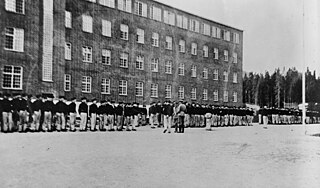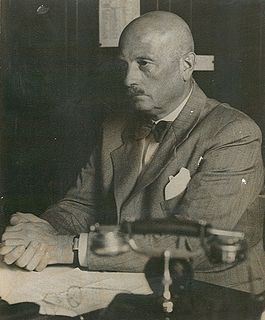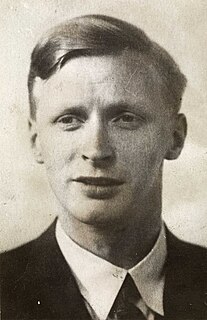Related Research Articles

Grini prison camp was a Nazi concentration camp in Bærum, Norway, which operated between 1941 and May 1945. Ila Detention and Security Prison is now located here.
Gunvor "Vesla" Vetlesen, née Hansen is a Norwegian weaver, trade unionist, writer and politician for the Labour Party. She was Minister of International Development from 1986 to 1988.
Olaf Solumsmoen was a Norwegian newspaper editor and politician for the Labour Party.

Olav Larssen was a Norwegian newspaper editor and politician for the Labour and Communist parties.
Christian A. R. Christensen was a Norwegian newspaper editor. He is known for his work in the Norwegian resistance movement, as editor of Verdens Gang and as a historical writer. He also helped shape the Ethical Code of Practice for the Norwegian Press.
Tore Gjelsvik was a Norwegian geologist and polar explorer. He headed the Norwegian Polar Institute from 1960 to 1983, and played an important role in the Norwegian resistance during World War II.
Oslogjengen was a sabotage group operating in Oslo from May 1944 to May 1945, during the last year of the occupation of Norway by Nazi Germany. The group had its basis in both the British Special Operations Executive and the Norwegian Milorg, was coordinated by Gunnar Sønsteby, and had around ten members. It was the dominant sabotage group in Oslo between May and September 1944, when they performed a series of successful sabotage operations.

Petter Moen was a Norwegian resistance member later known for his diaries.
Norsk fangeleksikon. Grinifangene is a Norwegian biographical dictionary with details on prisoners incarcerated at the Grini concentration camp between 1941 and 1945.

Kristian Welhaven was a Norwegian police officer. He was chief of police of Oslo for 27 years, from 1927 to 1954. He was a leading force in establishing an organized Norwegian intelligence service before World War II, and in re-establishing it after the war. During the war years Welhaven was arrested by the Germans and imprisoned in both Norway and Germany, before spending the remainder of the war as a civilian internee in Bavaria.
Gunnar Haarstad was a Norwegian jurist and police officer, a resistance member during World War II, and later head of the Norwegian Police Surveillance Agency for fifteen years.

Julius Hougen was a Norwegian jurist and radio personality. He became known as the voice from Sørlandet over a period of more than forty years, eventually as a leader of the Norwegian Broadcasting Corporation's district office in Kristiansand.

Rolf Hofmo was a Norwegian politician and sports official.
The milk strike was a strike in Nazi-occupied Oslo on 8 and 9 September 1941. It led to strong reprisals from the German occupiers, in the form of martial law, court-martial, mass arrests, two executions and several long-term jail sentences.

Josef Larsson was a Norwegian metal worker and trade unionist, born in Sweden. From 1931 he was a secretary for the Norwegian Union of Iron and Metalworkers. He was a board member of the Norwegian Labour Party from 1927 to 1930.
Odd Fossum was a Norwegian shop assistant, and leader of the Norwegian Confederation of Trade Unions from 1941 to 1945, under the Nazi regime during the occupation of Norway by Nazi Germany. He was also the leader of NS Faggruppeorganisasjon from 12 October 1940 to September 1944, when he was succeeded by Olav M. Hoff.
Nils Arntzen Ramm was a Norwegian engineer, military captain, and businessperson.
Jakob Schive was a Norwegian military officer, geodesist and Milorg pioneer.
Halvor Hansson was a Norwegian military officer.
Håkon Evjenth was a Norwegian jurist, non-fiction writer, short-story writer and children's writer. He is probably best remembered for his children's books.
References
- 1 2 3 4 Halvorsen, Terje (1995). "Bulletinen". In Dahl; Hjeltnes; Nøkleby; Ringdal; Sørensen (eds.). Norsk krigsleksikon 1940-45 (in Norwegian). Oslo: Cappelen. pp. 56–57. ISBN 82-02-14138-9. Archived from the original on 4 January 2010. Retrieved 4 September 2009.
- 1 2 Voksø, Per, ed. (1984). "Bulletinen, offisiell, men illegal avis". Krigens Dagbok (in Norwegian). Oslo: Det Beste. p. 86. ISBN 82-7010-166-4.
- ↑ Gjelsvik, Tore (1977). "Norsk Front— R-gruppen". Hjemmefronten. Den sivile motstand under okkupasjonen 1940-1945 (in Norwegian). Oslo: Cappelen. pp. 25–28.
- ↑ Giertsen, Børre R., ed. (1946). "2751. Larsen, Olav". Norsk Fangeleksikon. Grinifangene (in Norwegian). Oslo: Cappelen. p. 102.
- ↑ Giertsen, Børre R., ed. (1946). "2756. Solumsmoen, Olaf". Norsk Fangeleksikon. Grinifangene (in Norwegian). Oslo: Cappelen. p. 103.
- ↑ Giertsen, Børre R., ed. (1946). "4058. Halvorsen, Asbjørn". Norsk Fangeleksikon. Grinifangene (in Norwegian). Oslo: Cappelen. p. 148.
- ↑ Giertsen, Børre R., ed. (1946). "4084. Hansen, Gunnar". Norsk Fangeleksikon. Grinifangene (in Norwegian). Oslo: Cappelen. p. 149.
- ↑ Voksø, Per, ed. (1984). "Vaktskifte i Bulletinen". Krigens Dagbok (in Norwegian). Oslo: Det Beste. p. 423. ISBN 82-7010-166-4.
- 1 2 Gjelsvik, Tore (1977). "Redaksjonsskifte i Bulletinen". Hjemmefronten. Den sivile motstand under okkupasjonen 1940-1945 (in Norwegian). Oslo: Cappelen. pp. 183–184.
- ↑ Voksø, Per, ed. (1984). "Det store pressekrakket". Krigens Dagbok (in Norwegian). Oslo: Det Beste. p. 400. ISBN 82-7010-166-4.